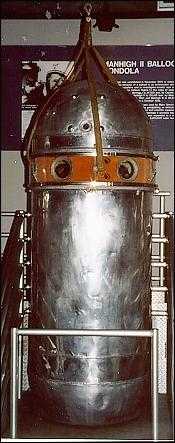Project Manhigh

Project Manhigh along with Project Excelsior was a pre–Space Age military project that took men in balloons to the middle layers of the Earth’s stratosphere.
History
The project started in December 1955 to study the effects of cosmic rays on humans. Three balloon flights to the stratosphere were made during the program:
- Manhigh I to 29,500 m (96,784 feet), by Captain Joseph W. Kittinger II (1928–) on June 2, 1957
- Manhigh II to 30,900 m (101,516 feet), by Major David G. Simons (1922–2010[1]) on August 19–20, 1957 for a 32-hour flight[2]
- Manhigh III to 29,900 m (98,097 feet), by Lieutenant Clifton M. McClure (1932–2001[3]) on October 8, 1958[4]
With the pilot and the scientific payload, the Manhigh II gondola had a total mass of 748 kg (1,649 lb). At maximum altitude, the balloon expanded to a diameter of 60 m (200 ft) with a volume of over 85,000 m3 (111,000 cu yd).
A similar project in which a man in a gondola reached an altitude of 15,785 m (51,788 ft) was performed in 1931 by the Swiss physicist Auguste Piccard.
In popular culture
"Manhigh" was the name of the 2013 season one finale of the Showtime series Masters of Sex, and featured television coverage of Major David Simons' mission and return to earth.
References
Bibliography
- Kane, Joseph Nathan (1997), Famous First Facts: A Record of First Happenings, Discoveries, and Inventions in American History (Fifth Edition), The H.W. Wilson Company, ISBN 0-8242-0930-3
Further reading
- Kennedy, Gregory P. (2007). Touching Space: The Story of Project Manhigh. Atglen, Pennsylvania: Schiffer Books. ISBN 978-0-7643-2788-9.
- Ryan, Craig (1995). The Pre-Astronauts: Manned Ballooning on the Threshold of Space. Naval Institute Press. ISBN 1-55750-732-5.
- Simons, David G.; Schanche, Don A. (1960). Manhigh. Avon Books.